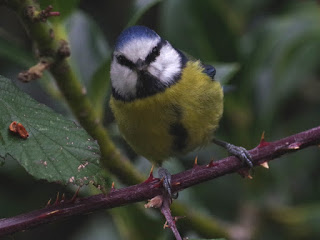... was accompanied by eight males. The sex ratio of most ducks is seriously skewed by their habit of nesting on the ground. Sitting females are often killed by foxes and other predators. Pochards are particularly badly affected, and the species is now redlisted.
The Black Swan charged in to get to someone feeding the waterfowl, scattering Black-Headed Gulls.
A Great Crested Grebe fishing under the fallen willow looked austerely elegant in plain winter plumage.
The notorious Lesser Black-Backed Gull was between pigeons, and preened his well-kept plumage.
The young Grey Heron in the Dell shook out its feathers.
Three Carrion Crows played in the breeze above the Lido restaurant.
Another crow had found a bit of stale flatbread under a table at the Lido resturant. This tough stuff can be difficult to deal with, especially when there are other crows around eager to grab it, so the crow took it away to eat in a more private place.
There is usually only one Mistle Thrush on Buck Hill. It has given up waiting for others to arrive for a communal visit to the rowan tree, and was eating fruit by itself.
Blackbirds flew in contantly from the neighbouring hawthorn tree which is their headquarters.
This hawthorn has been used by winter migrant Blackbirds for years, and it can't have been the same flock all this time. Perhaps they like the extra security given by the thorns.
Thorns certainly don't bother small birds such as this Blue Tit waiting to be fed near the bridge.
There are also plenty of Great Tits here.
But the place in the leaf yard where people feed the small birds is now losing its population, almost certainly because of the mob of Rose-Ringed Parakeets encouraged by people coming to feed them.
Long-Tailed Tits are unaffected because they are always on the move.
I'm trying to make friends with this Blackbird in the Rose Garden. Blackbirds love sultanas, but are very wary of humans. It takes many days of feeding before they become confident about taking the offering.
Goldfinches also keep their distance from humans, and can flee from the top of a tall tree simply if you look at them from the ground. There are never many of them in the park, though if you go to a less frequented place such as Brompton Cemetery you may see literally hundreds of them. They are also common in the streets, and like to perch on television aerials.












I find it sad that Goldfinches and Blackbirds should be as timid and wary in England as they are in Spain. I assume it must be their nature, and not mistreatment (being hunted or trapped is what historically caused songbirds to fear humans over here). But if there is anyone that can bring a timid Blackbird out, that's Ralph.
ReplyDeleteIt's just a matter of time till that Blackbird comes out confidently. It took a while to get the white-faced Blackbird to trust me. (But I haven't seen her for several months and fear she has dropped off the twig.)
DeleteI find British resident Blackbirds seem to share some of our Robins' mentality of seeing humans as potential cover from predators as well as disturbers of invertebrate prey. Jim
DeleteYes. But this one has not been taking advantage of the replanting of the herbaceous borders nearby, as the Robins have. It may be a migrant.
DeleteThe tits near the bridge - is that the Sackler or Serpentine gallery side and on the Long Water or the Serpentine lake side? I'd like to pass by with some pine nuts when the weather's miserable. I'll still pass by the leaf yard as well and chase away the parakeets to see if some small birds are around.
ReplyDeleteI chuckled at the "between pigeons" aside. A touch of the Alan Bennetts there.
It's the SW corner of the bridge, nearest to the original Serpentine Gallery. There's a little path with a flight of steps through the shrubbery here, leading up to the bridge. The tits may be here or on the path below.
DeleteRalph- though female ground-nesting ducks no doubt suffer higher predator issues, certainly with Pochard females tend to migrate further south than drakes. If you ever visit Welney WWT Reserve in the winter you'll see maybe a couple of hundred drakes + very few ducks. The latter tend to go to France + Spain for the winter.
ReplyDeleteCan confirm.
DeleteWell I'd never have learnt this from me bird books. Jim
DeleteYes apparently they winter in different areas. The few we see in Ireland are mainly male.
ReplyDeleteI stand corrected. Nevertheless, the BTO is so concerned about sex ratios in Common Pochards that they had a nationwide survey on this a couple of years ago, in which I took part.
Delete